Retailers' Sustainability Strategies and Global Operations
VerifiedAdded on 2020/07/22
|12
|3357
|87
AI Summary
This assignment delves into the strategic orientations of international retail businesses, focusing on sustainability initiatives, global operations, and corporate social responsibility. It examines case studies like Sainsbury's to evaluate their environmental impact, service quality, and marketing strategies in an international context.
Contribute Materials
Your contribution can guide someone’s learning journey. Share your
documents today.
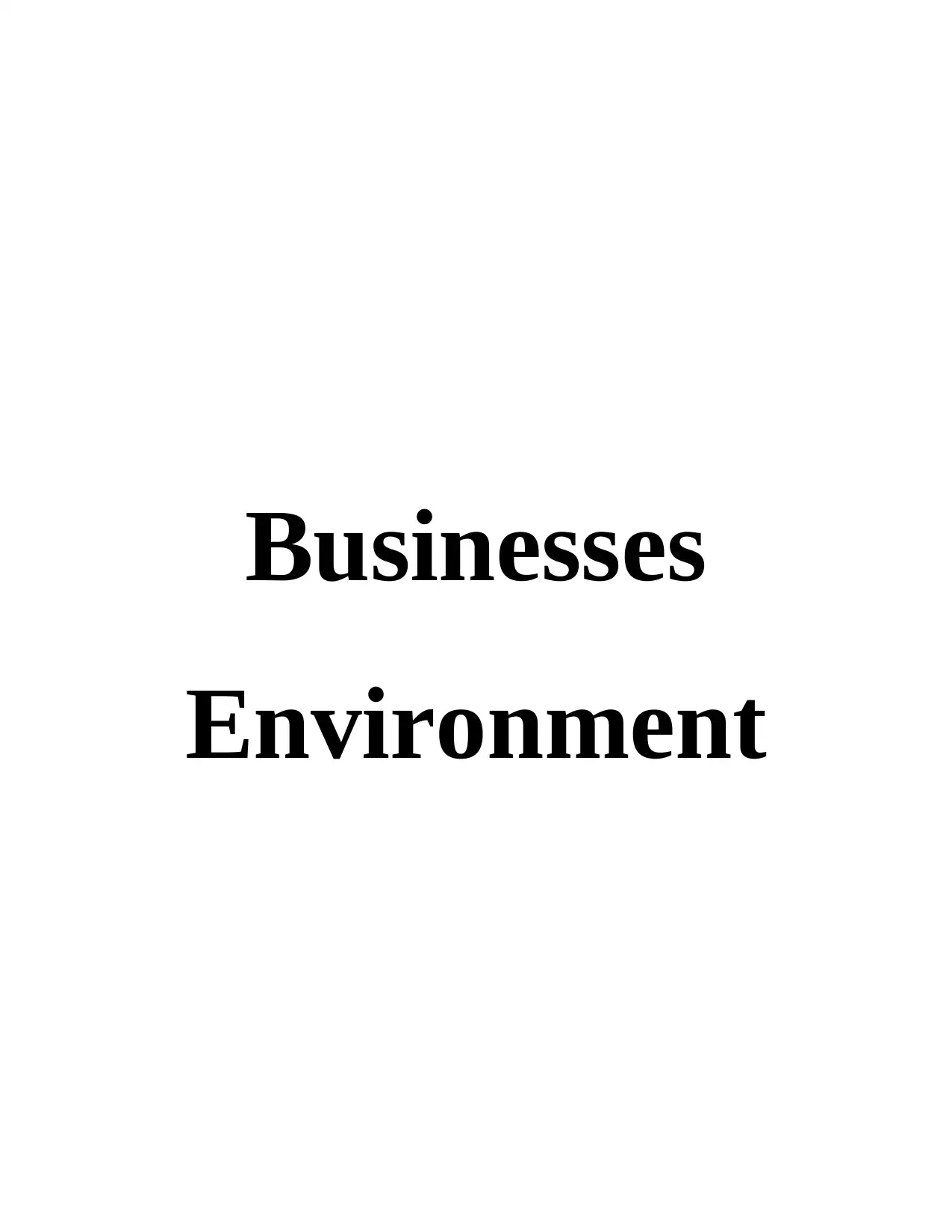
Businesses
Environment
Environment
Secure Best Marks with AI Grader
Need help grading? Try our AI Grader for instant feedback on your assignments.
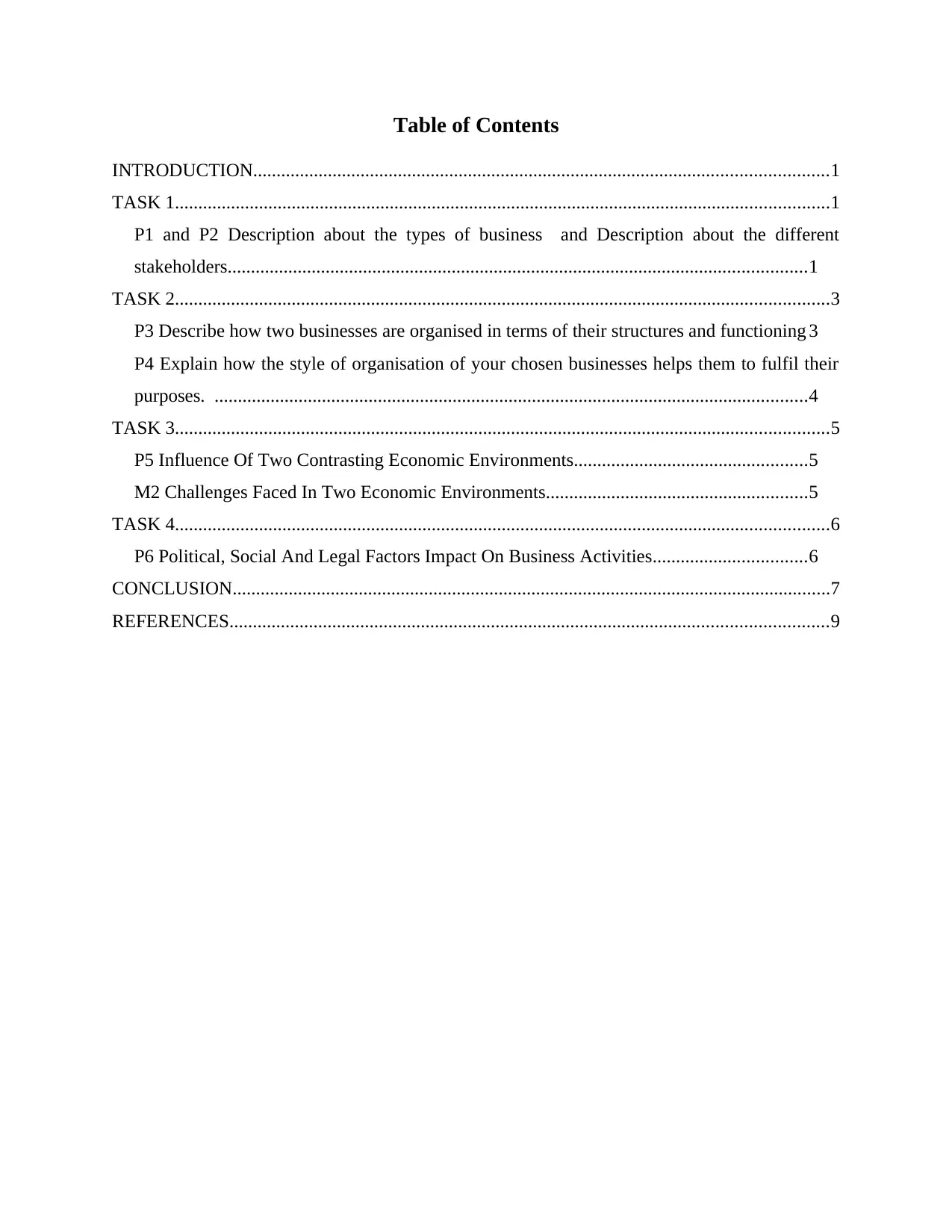
Table of Contents
INTRODUCTION...........................................................................................................................1
TASK 1............................................................................................................................................1
P1 and P2 Description about the types of business and Description about the different
stakeholders............................................................................................................................1
TASK 2............................................................................................................................................3
P3 Describe how two businesses are organised in terms of their structures and functioning 3
P4 Explain how the style of organisation of your chosen businesses helps them to fulfil their
purposes. ...............................................................................................................................4
TASK 3............................................................................................................................................5
P5 Influence Of Two Contrasting Economic Environments..................................................5
M2 Challenges Faced In Two Economic Environments........................................................5
TASK 4............................................................................................................................................6
P6 Political, Social And Legal Factors Impact On Business Activities.................................6
CONCLUSION................................................................................................................................7
REFERENCES................................................................................................................................9
INTRODUCTION...........................................................................................................................1
TASK 1............................................................................................................................................1
P1 and P2 Description about the types of business and Description about the different
stakeholders............................................................................................................................1
TASK 2............................................................................................................................................3
P3 Describe how two businesses are organised in terms of their structures and functioning 3
P4 Explain how the style of organisation of your chosen businesses helps them to fulfil their
purposes. ...............................................................................................................................4
TASK 3............................................................................................................................................5
P5 Influence Of Two Contrasting Economic Environments..................................................5
M2 Challenges Faced In Two Economic Environments........................................................5
TASK 4............................................................................................................................................6
P6 Political, Social And Legal Factors Impact On Business Activities.................................6
CONCLUSION................................................................................................................................7
REFERENCES................................................................................................................................9
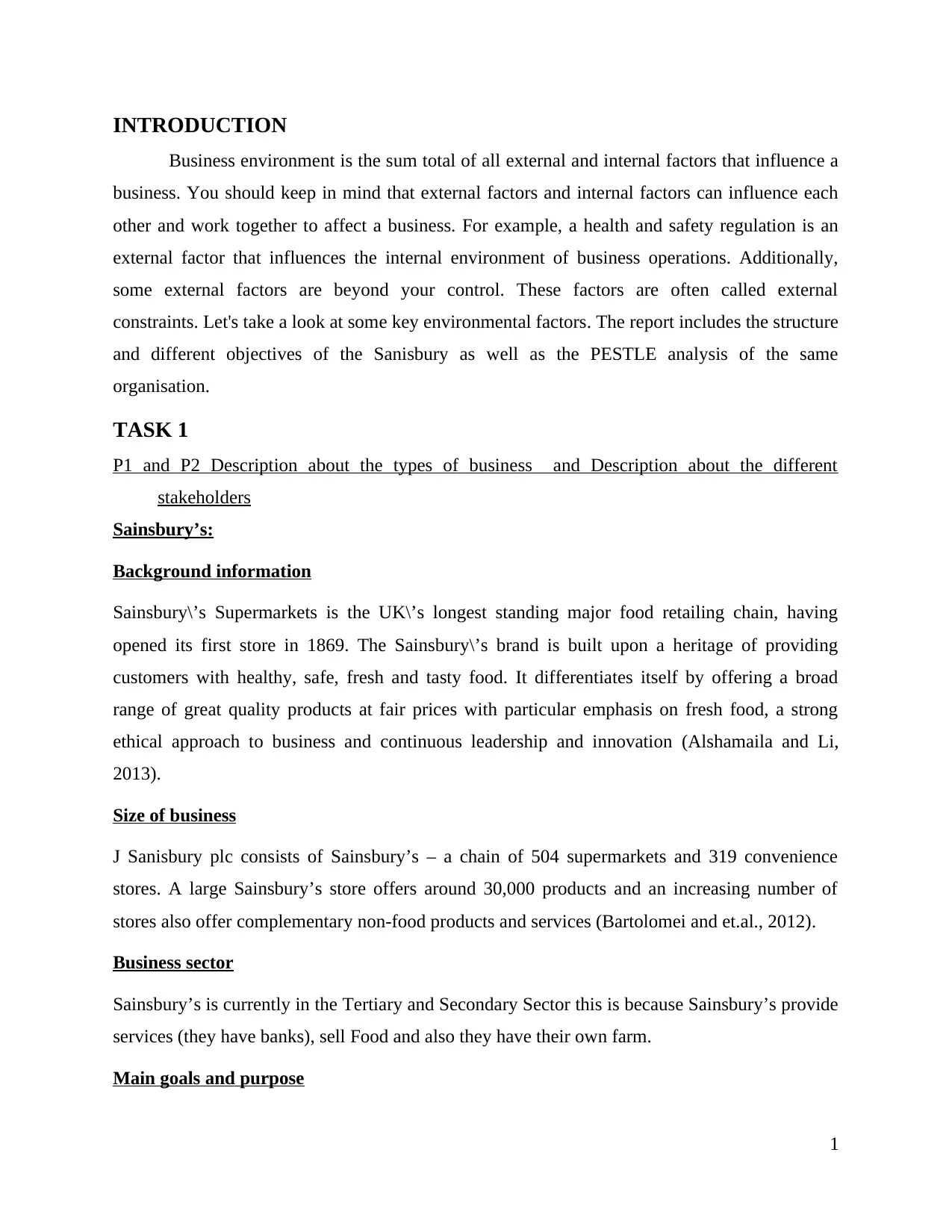
INTRODUCTION
Business environment is the sum total of all external and internal factors that influence a
business. You should keep in mind that external factors and internal factors can influence each
other and work together to affect a business. For example, a health and safety regulation is an
external factor that influences the internal environment of business operations. Additionally,
some external factors are beyond your control. These factors are often called external
constraints. Let's take a look at some key environmental factors. The report includes the structure
and different objectives of the Sanisbury as well as the PESTLE analysis of the same
organisation.
TASK 1
P1 and P2 Description about the types of business and Description about the different
stakeholders
Sainsbury’s:
Background information
Sainsbury\’s Supermarkets is the UK\’s longest standing major food retailing chain, having
opened its first store in 1869. The Sainsbury\’s brand is built upon a heritage of providing
customers with healthy, safe, fresh and tasty food. It differentiates itself by offering a broad
range of great quality products at fair prices with particular emphasis on fresh food, a strong
ethical approach to business and continuous leadership and innovation (Alshamaila and Li,
2013).
Size of business
J Sanisbury plc consists of Sainsbury’s – a chain of 504 supermarkets and 319 convenience
stores. A large Sainsbury’s store offers around 30,000 products and an increasing number of
stores also offer complementary non-food products and services (Bartolomei and et.al., 2012).
Business sector
Sainsbury’s is currently in the Tertiary and Secondary Sector this is because Sainsbury’s provide
services (they have banks), sell Food and also they have their own farm.
Main goals and purpose
1
Business environment is the sum total of all external and internal factors that influence a
business. You should keep in mind that external factors and internal factors can influence each
other and work together to affect a business. For example, a health and safety regulation is an
external factor that influences the internal environment of business operations. Additionally,
some external factors are beyond your control. These factors are often called external
constraints. Let's take a look at some key environmental factors. The report includes the structure
and different objectives of the Sanisbury as well as the PESTLE analysis of the same
organisation.
TASK 1
P1 and P2 Description about the types of business and Description about the different
stakeholders
Sainsbury’s:
Background information
Sainsbury\’s Supermarkets is the UK\’s longest standing major food retailing chain, having
opened its first store in 1869. The Sainsbury\’s brand is built upon a heritage of providing
customers with healthy, safe, fresh and tasty food. It differentiates itself by offering a broad
range of great quality products at fair prices with particular emphasis on fresh food, a strong
ethical approach to business and continuous leadership and innovation (Alshamaila and Li,
2013).
Size of business
J Sanisbury plc consists of Sainsbury’s – a chain of 504 supermarkets and 319 convenience
stores. A large Sainsbury’s store offers around 30,000 products and an increasing number of
stores also offer complementary non-food products and services (Bartolomei and et.al., 2012).
Business sector
Sainsbury’s is currently in the Tertiary and Secondary Sector this is because Sainsbury’s provide
services (they have banks), sell Food and also they have their own farm.
Main goals and purpose
1
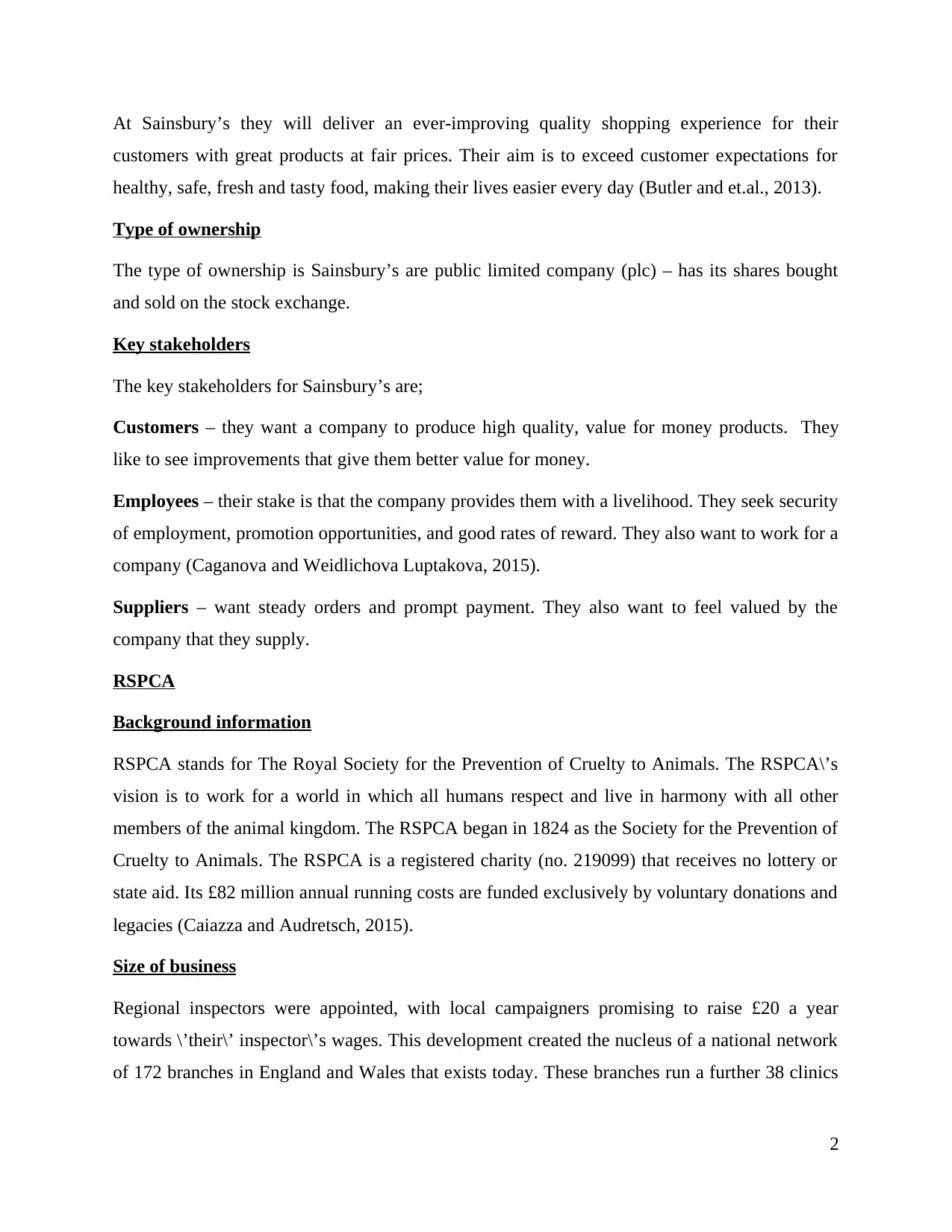
At Sainsbury’s they will deliver an ever-improving quality shopping experience for their
customers with great products at fair prices. Their aim is to exceed customer expectations for
healthy, safe, fresh and tasty food, making their lives easier every day (Butler and et.al., 2013).
Type of ownership
The type of ownership is Sainsbury’s are public limited company (plc) – has its shares bought
and sold on the stock exchange.
Key stakeholders
The key stakeholders for Sainsbury’s are;
Customers – they want a company to produce high quality, value for money products. They
like to see improvements that give them better value for money.
Employees – their stake is that the company provides them with a livelihood. They seek security
of employment, promotion opportunities, and good rates of reward. They also want to work for a
company (Caganova and Weidlichova Luptakova, 2015).
Suppliers – want steady orders and prompt payment. They also want to feel valued by the
company that they supply.
RSPCA
Background information
RSPCA stands for The Royal Society for the Prevention of Cruelty to Animals. The RSPCA\’s
vision is to work for a world in which all humans respect and live in harmony with all other
members of the animal kingdom. The RSPCA began in 1824 as the Society for the Prevention of
Cruelty to Animals. The RSPCA is a registered charity (no. 219099) that receives no lottery or
state aid. Its £82 million annual running costs are funded exclusively by voluntary donations and
legacies (Caiazza and Audretsch, 2015).
Size of business
Regional inspectors were appointed, with local campaigners promising to raise £20 a year
towards \’their\’ inspector\’s wages. This development created the nucleus of a national network
of 172 branches in England and Wales that exists today. These branches run a further 38 clinics
2
customers with great products at fair prices. Their aim is to exceed customer expectations for
healthy, safe, fresh and tasty food, making their lives easier every day (Butler and et.al., 2013).
Type of ownership
The type of ownership is Sainsbury’s are public limited company (plc) – has its shares bought
and sold on the stock exchange.
Key stakeholders
The key stakeholders for Sainsbury’s are;
Customers – they want a company to produce high quality, value for money products. They
like to see improvements that give them better value for money.
Employees – their stake is that the company provides them with a livelihood. They seek security
of employment, promotion opportunities, and good rates of reward. They also want to work for a
company (Caganova and Weidlichova Luptakova, 2015).
Suppliers – want steady orders and prompt payment. They also want to feel valued by the
company that they supply.
RSPCA
Background information
RSPCA stands for The Royal Society for the Prevention of Cruelty to Animals. The RSPCA\’s
vision is to work for a world in which all humans respect and live in harmony with all other
members of the animal kingdom. The RSPCA began in 1824 as the Society for the Prevention of
Cruelty to Animals. The RSPCA is a registered charity (no. 219099) that receives no lottery or
state aid. Its £82 million annual running costs are funded exclusively by voluntary donations and
legacies (Caiazza and Audretsch, 2015).
Size of business
Regional inspectors were appointed, with local campaigners promising to raise £20 a year
towards \’their\’ inspector\’s wages. This development created the nucleus of a national network
of 172 branches in England and Wales that exists today. These branches run a further 38 clinics
2
Secure Best Marks with AI Grader
Need help grading? Try our AI Grader for instant feedback on your assignments.

and 33 animal centres. In addition to the branch run establishments there is one other animal
centre run by a trust and another run by a charitable company.
Business sector
RSPCA is currently is the tertiary sector this is because RSPCA provides services to help the
animals that need care or special treatments (Alshamaila and Li, 2013).
Main goals and purpose
The main goals for RSPCA is reducing the use and suffering of dogs in medicines testing. The
purpose is to give animals with special needs and give pets a loving care homes.
Type of ownership
The type of ownership RSPCA fit into is charitable trust; this is set up to raise funds and support
other people and animals for good cause (Bartolomei and et.al., 2012).
Key stakeholders
Employees – the employees will need to be happy to be working on a voluntary basis and also
need to be caring for the animals that are suffering.
Governments – the government wants the business to be successful – it wants to see prosperous
businesses that take a full responsibility in looking after the welfare of society.
Local and national communities – the actions of business can have a dramatic effect on
communities. Community leaders therefore represent important interest groups (Butler and et.al.,
2013).
TASK 2
P3 Describe how two businesses are organised in terms of their structures and functioning
Organizational structure is a system that consists of explicit and implicit institutional
rules and policies designed to outline how various work roles and responsibilities are delegated,
controlled and coordinated. Organizational structure also determines how information flows
from level to level within the company. For example, in a centralized structure, decisions flow
from the top down, while in a decentralized structure, the decisions are made at various different
level.
3
centre run by a trust and another run by a charitable company.
Business sector
RSPCA is currently is the tertiary sector this is because RSPCA provides services to help the
animals that need care or special treatments (Alshamaila and Li, 2013).
Main goals and purpose
The main goals for RSPCA is reducing the use and suffering of dogs in medicines testing. The
purpose is to give animals with special needs and give pets a loving care homes.
Type of ownership
The type of ownership RSPCA fit into is charitable trust; this is set up to raise funds and support
other people and animals for good cause (Bartolomei and et.al., 2012).
Key stakeholders
Employees – the employees will need to be happy to be working on a voluntary basis and also
need to be caring for the animals that are suffering.
Governments – the government wants the business to be successful – it wants to see prosperous
businesses that take a full responsibility in looking after the welfare of society.
Local and national communities – the actions of business can have a dramatic effect on
communities. Community leaders therefore represent important interest groups (Butler and et.al.,
2013).
TASK 2
P3 Describe how two businesses are organised in terms of their structures and functioning
Organizational structure is a system that consists of explicit and implicit institutional
rules and policies designed to outline how various work roles and responsibilities are delegated,
controlled and coordinated. Organizational structure also determines how information flows
from level to level within the company. For example, in a centralized structure, decisions flow
from the top down, while in a decentralized structure, the decisions are made at various different
level.
3
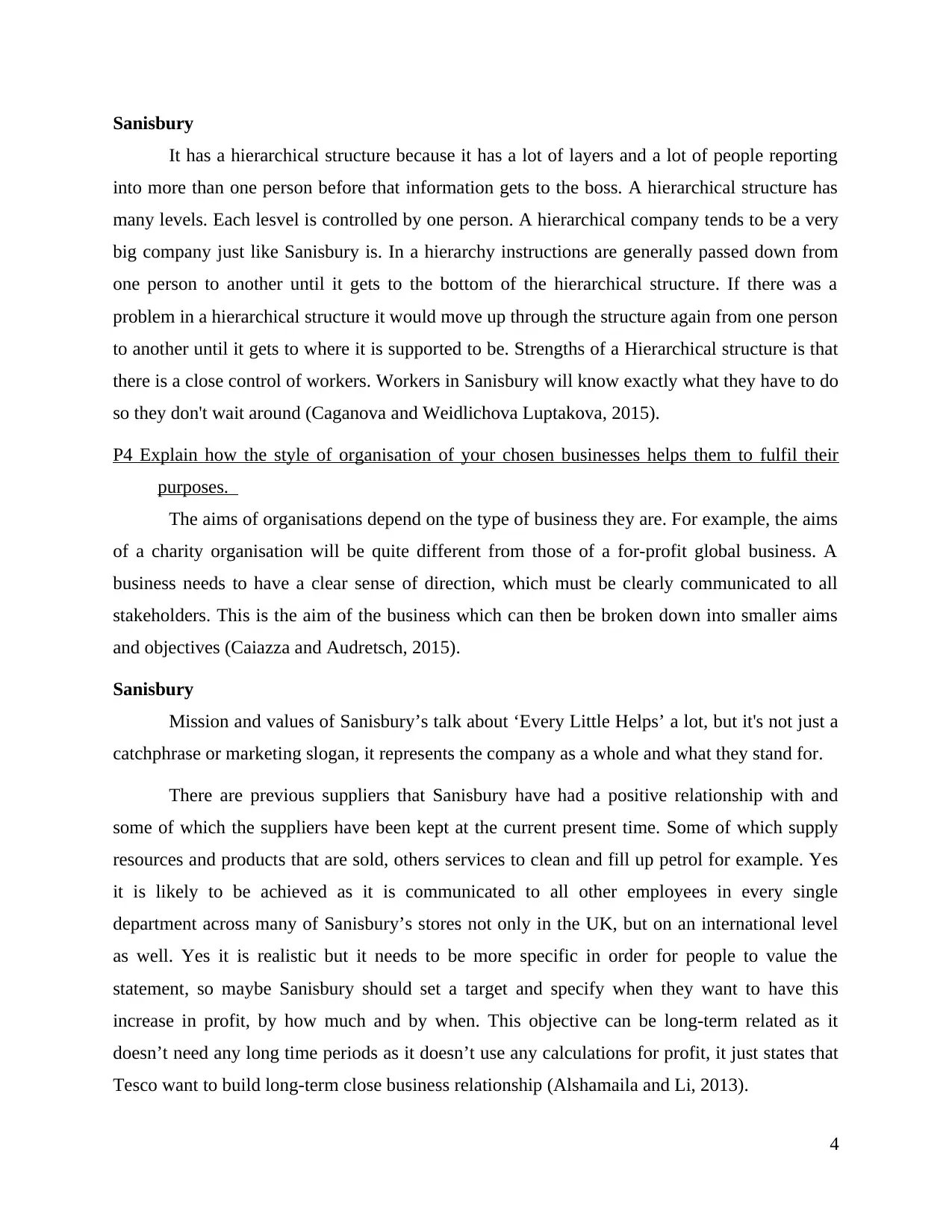
Sanisbury
It has a hierarchical structure because it has a lot of layers and a lot of people reporting
into more than one person before that information gets to the boss. A hierarchical structure has
many levels. Each lesvel is controlled by one person. A hierarchical company tends to be a very
big company just like Sanisbury is. In a hierarchy instructions are generally passed down from
one person to another until it gets to the bottom of the hierarchical structure. If there was a
problem in a hierarchical structure it would move up through the structure again from one person
to another until it gets to where it is supported to be. Strengths of a Hierarchical structure is that
there is a close control of workers. Workers in Sanisbury will know exactly what they have to do
so they don't wait around (Caganova and Weidlichova Luptakova, 2015).
P4 Explain how the style of organisation of your chosen businesses helps them to fulfil their
purposes.
The aims of organisations depend on the type of business they are. For example, the aims
of a charity organisation will be quite different from those of a for-profit global business. A
business needs to have a clear sense of direction, which must be clearly communicated to all
stakeholders. This is the aim of the business which can then be broken down into smaller aims
and objectives (Caiazza and Audretsch, 2015).
Sanisbury
Mission and values of Sanisbury’s talk about ‘Every Little Helps’ a lot, but it's not just a
catchphrase or marketing slogan, it represents the company as a whole and what they stand for.
There are previous suppliers that Sanisbury have had a positive relationship with and
some of which the suppliers have been kept at the current present time. Some of which supply
resources and products that are sold, others services to clean and fill up petrol for example. Yes
it is likely to be achieved as it is communicated to all other employees in every single
department across many of Sanisbury’s stores not only in the UK, but on an international level
as well. Yes it is realistic but it needs to be more specific in order for people to value the
statement, so maybe Sanisbury should set a target and specify when they want to have this
increase in profit, by how much and by when. This objective can be long-term related as it
doesn’t need any long time periods as it doesn’t use any calculations for profit, it just states that
Tesco want to build long-term close business relationship (Alshamaila and Li, 2013).
4
It has a hierarchical structure because it has a lot of layers and a lot of people reporting
into more than one person before that information gets to the boss. A hierarchical structure has
many levels. Each lesvel is controlled by one person. A hierarchical company tends to be a very
big company just like Sanisbury is. In a hierarchy instructions are generally passed down from
one person to another until it gets to the bottom of the hierarchical structure. If there was a
problem in a hierarchical structure it would move up through the structure again from one person
to another until it gets to where it is supported to be. Strengths of a Hierarchical structure is that
there is a close control of workers. Workers in Sanisbury will know exactly what they have to do
so they don't wait around (Caganova and Weidlichova Luptakova, 2015).
P4 Explain how the style of organisation of your chosen businesses helps them to fulfil their
purposes.
The aims of organisations depend on the type of business they are. For example, the aims
of a charity organisation will be quite different from those of a for-profit global business. A
business needs to have a clear sense of direction, which must be clearly communicated to all
stakeholders. This is the aim of the business which can then be broken down into smaller aims
and objectives (Caiazza and Audretsch, 2015).
Sanisbury
Mission and values of Sanisbury’s talk about ‘Every Little Helps’ a lot, but it's not just a
catchphrase or marketing slogan, it represents the company as a whole and what they stand for.
There are previous suppliers that Sanisbury have had a positive relationship with and
some of which the suppliers have been kept at the current present time. Some of which supply
resources and products that are sold, others services to clean and fill up petrol for example. Yes
it is likely to be achieved as it is communicated to all other employees in every single
department across many of Sanisbury’s stores not only in the UK, but on an international level
as well. Yes it is realistic but it needs to be more specific in order for people to value the
statement, so maybe Sanisbury should set a target and specify when they want to have this
increase in profit, by how much and by when. This objective can be long-term related as it
doesn’t need any long time periods as it doesn’t use any calculations for profit, it just states that
Tesco want to build long-term close business relationship (Alshamaila and Li, 2013).
4
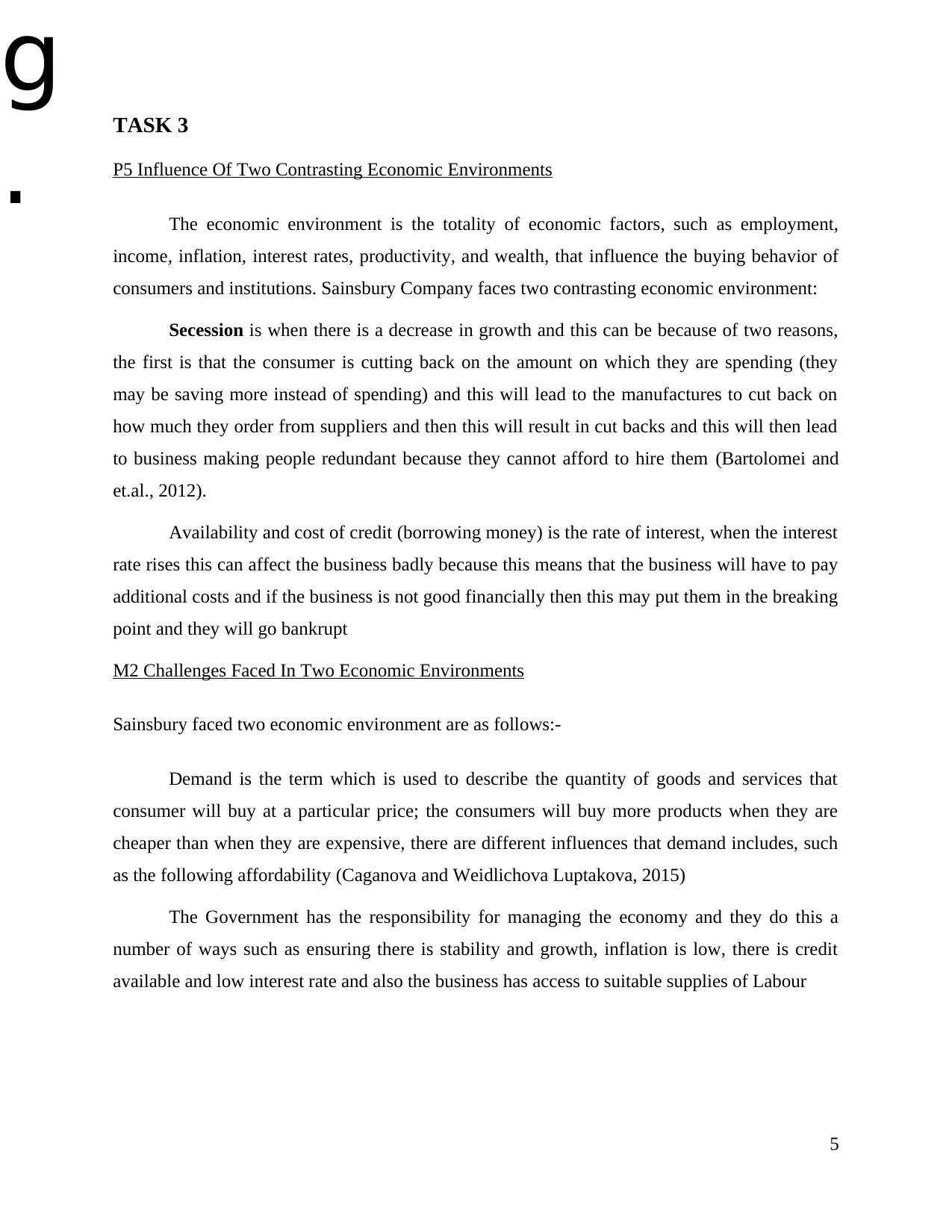
TASK 3
P5 Influence Of Two Contrasting Economic Environments
The economic environment is the totality of economic factors, such as employment,
income, inflation, interest rates, productivity, and wealth, that influence the buying behavior of
consumers and institutions. Sainsbury Company faces two contrasting economic environment:
Secession is when there is a decrease in growth and this can be because of two reasons,
the first is that the consumer is cutting back on the amount on which they are spending (they
may be saving more instead of spending) and this will lead to the manufactures to cut back on
how much they order from suppliers and then this will result in cut backs and this will then lead
to business making people redundant because they cannot afford to hire them (Bartolomei and
et.al., 2012).
Availability and cost of credit (borrowing money) is the rate of interest, when the interest
rate rises this can affect the business badly because this means that the business will have to pay
additional costs and if the business is not good financially then this may put them in the breaking
point and they will go bankrupt
M2 Challenges Faced In Two Economic Environments
Sainsbury faced two economic environment are as follows:-
Demand is the term which is used to describe the quantity of goods and services that
consumer will buy at a particular price; the consumers will buy more products when they are
cheaper than when they are expensive, there are different influences that demand includes, such
as the following affordability (Caganova and Weidlichova Luptakova, 2015)
The Government has the responsibility for managing the economy and they do this a
number of ways such as ensuring there is stability and growth, inflation is low, there is credit
available and low interest rate and also the business has access to suitable supplies of Labour
5
g
.
S
a
i
n
s
b
u
r
y
P5 Influence Of Two Contrasting Economic Environments
The economic environment is the totality of economic factors, such as employment,
income, inflation, interest rates, productivity, and wealth, that influence the buying behavior of
consumers and institutions. Sainsbury Company faces two contrasting economic environment:
Secession is when there is a decrease in growth and this can be because of two reasons,
the first is that the consumer is cutting back on the amount on which they are spending (they
may be saving more instead of spending) and this will lead to the manufactures to cut back on
how much they order from suppliers and then this will result in cut backs and this will then lead
to business making people redundant because they cannot afford to hire them (Bartolomei and
et.al., 2012).
Availability and cost of credit (borrowing money) is the rate of interest, when the interest
rate rises this can affect the business badly because this means that the business will have to pay
additional costs and if the business is not good financially then this may put them in the breaking
point and they will go bankrupt
M2 Challenges Faced In Two Economic Environments
Sainsbury faced two economic environment are as follows:-
Demand is the term which is used to describe the quantity of goods and services that
consumer will buy at a particular price; the consumers will buy more products when they are
cheaper than when they are expensive, there are different influences that demand includes, such
as the following affordability (Caganova and Weidlichova Luptakova, 2015)
The Government has the responsibility for managing the economy and they do this a
number of ways such as ensuring there is stability and growth, inflation is low, there is credit
available and low interest rate and also the business has access to suitable supplies of Labour
5
g
.
S
a
i
n
s
b
u
r
y
Paraphrase This Document
Need a fresh take? Get an instant paraphrase of this document with our AI Paraphraser
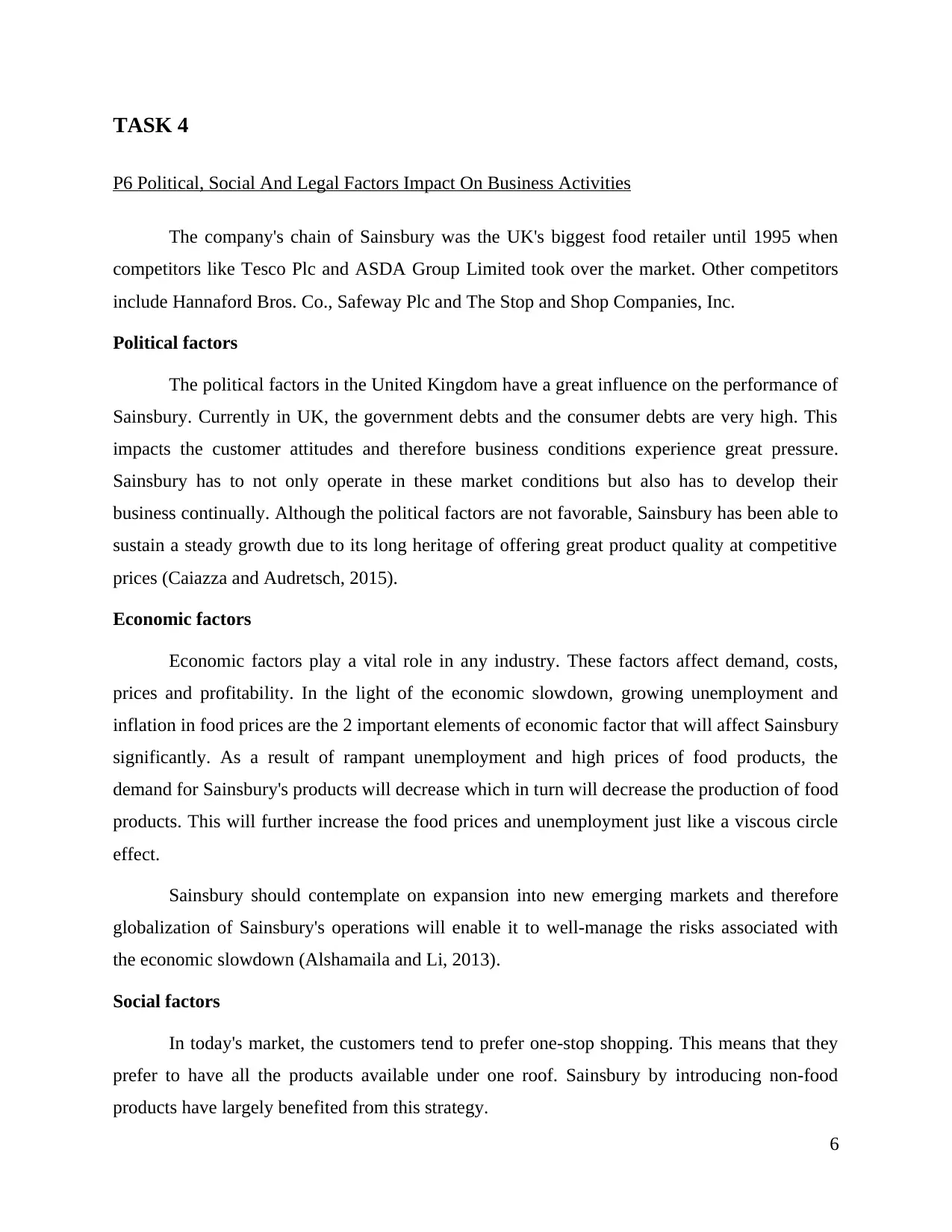
TASK 4
P6 Political, Social And Legal Factors Impact On Business Activities
The company's chain of Sainsbury was the UK's biggest food retailer until 1995 when
competitors like Tesco Plc and ASDA Group Limited took over the market. Other competitors
include Hannaford Bros. Co., Safeway Plc and The Stop and Shop Companies, Inc.
Political factors
The political factors in the United Kingdom have a great influence on the performance of
Sainsbury. Currently in UK, the government debts and the consumer debts are very high. This
impacts the customer attitudes and therefore business conditions experience great pressure.
Sainsbury has to not only operate in these market conditions but also has to develop their
business continually. Although the political factors are not favorable, Sainsbury has been able to
sustain a steady growth due to its long heritage of offering great product quality at competitive
prices (Caiazza and Audretsch, 2015).
Economic factors
Economic factors play a vital role in any industry. These factors affect demand, costs,
prices and profitability. In the light of the economic slowdown, growing unemployment and
inflation in food prices are the 2 important elements of economic factor that will affect Sainsbury
significantly. As a result of rampant unemployment and high prices of food products, the
demand for Sainsbury's products will decrease which in turn will decrease the production of food
products. This will further increase the food prices and unemployment just like a viscous circle
effect.
Sainsbury should contemplate on expansion into new emerging markets and therefore
globalization of Sainsbury's operations will enable it to well-manage the risks associated with
the economic slowdown (Alshamaila and Li, 2013).
Social factors
In today's market, the customers tend to prefer one-stop shopping. This means that they
prefer to have all the products available under one roof. Sainsbury by introducing non-food
products have largely benefited from this strategy.
6
P6 Political, Social And Legal Factors Impact On Business Activities
The company's chain of Sainsbury was the UK's biggest food retailer until 1995 when
competitors like Tesco Plc and ASDA Group Limited took over the market. Other competitors
include Hannaford Bros. Co., Safeway Plc and The Stop and Shop Companies, Inc.
Political factors
The political factors in the United Kingdom have a great influence on the performance of
Sainsbury. Currently in UK, the government debts and the consumer debts are very high. This
impacts the customer attitudes and therefore business conditions experience great pressure.
Sainsbury has to not only operate in these market conditions but also has to develop their
business continually. Although the political factors are not favorable, Sainsbury has been able to
sustain a steady growth due to its long heritage of offering great product quality at competitive
prices (Caiazza and Audretsch, 2015).
Economic factors
Economic factors play a vital role in any industry. These factors affect demand, costs,
prices and profitability. In the light of the economic slowdown, growing unemployment and
inflation in food prices are the 2 important elements of economic factor that will affect Sainsbury
significantly. As a result of rampant unemployment and high prices of food products, the
demand for Sainsbury's products will decrease which in turn will decrease the production of food
products. This will further increase the food prices and unemployment just like a viscous circle
effect.
Sainsbury should contemplate on expansion into new emerging markets and therefore
globalization of Sainsbury's operations will enable it to well-manage the risks associated with
the economic slowdown (Alshamaila and Li, 2013).
Social factors
In today's market, the customers tend to prefer one-stop shopping. This means that they
prefer to have all the products available under one roof. Sainsbury by introducing non-food
products have largely benefited from this strategy.
6
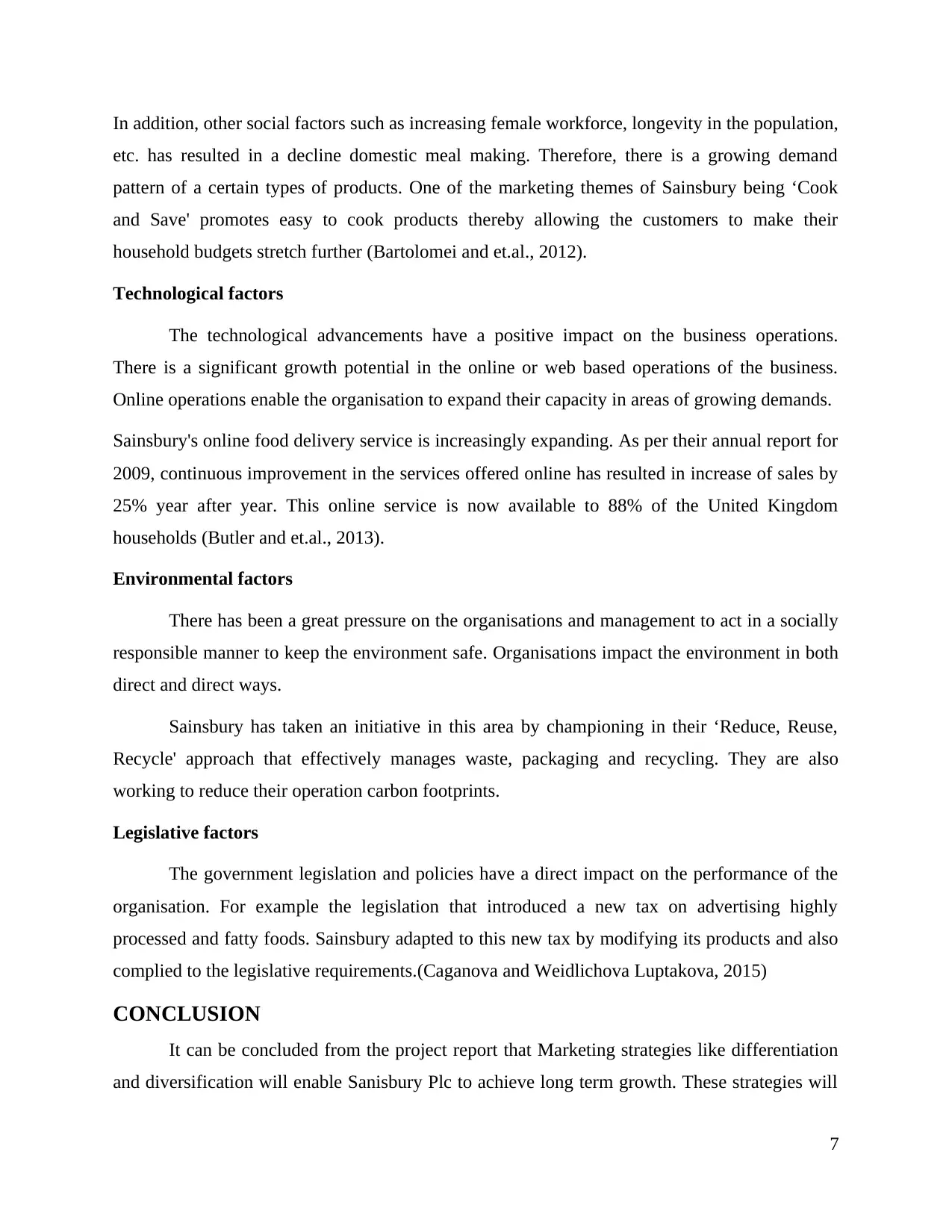
In addition, other social factors such as increasing female workforce, longevity in the population,
etc. has resulted in a decline domestic meal making. Therefore, there is a growing demand
pattern of a certain types of products. One of the marketing themes of Sainsbury being ‘Cook
and Save' promotes easy to cook products thereby allowing the customers to make their
household budgets stretch further (Bartolomei and et.al., 2012).
Technological factors
The technological advancements have a positive impact on the business operations.
There is a significant growth potential in the online or web based operations of the business.
Online operations enable the organisation to expand their capacity in areas of growing demands.
Sainsbury's online food delivery service is increasingly expanding. As per their annual report for
2009, continuous improvement in the services offered online has resulted in increase of sales by
25% year after year. This online service is now available to 88% of the United Kingdom
households (Butler and et.al., 2013).
Environmental factors
There has been a great pressure on the organisations and management to act in a socially
responsible manner to keep the environment safe. Organisations impact the environment in both
direct and direct ways.
Sainsbury has taken an initiative in this area by championing in their ‘Reduce, Reuse,
Recycle' approach that effectively manages waste, packaging and recycling. They are also
working to reduce their operation carbon footprints.
Legislative factors
The government legislation and policies have a direct impact on the performance of the
organisation. For example the legislation that introduced a new tax on advertising highly
processed and fatty foods. Sainsbury adapted to this new tax by modifying its products and also
complied to the legislative requirements.(Caganova and Weidlichova Luptakova, 2015)
CONCLUSION
It can be concluded from the project report that Marketing strategies like differentiation
and diversification will enable Sanisbury Plc to achieve long term growth. These strategies will
7
etc. has resulted in a decline domestic meal making. Therefore, there is a growing demand
pattern of a certain types of products. One of the marketing themes of Sainsbury being ‘Cook
and Save' promotes easy to cook products thereby allowing the customers to make their
household budgets stretch further (Bartolomei and et.al., 2012).
Technological factors
The technological advancements have a positive impact on the business operations.
There is a significant growth potential in the online or web based operations of the business.
Online operations enable the organisation to expand their capacity in areas of growing demands.
Sainsbury's online food delivery service is increasingly expanding. As per their annual report for
2009, continuous improvement in the services offered online has resulted in increase of sales by
25% year after year. This online service is now available to 88% of the United Kingdom
households (Butler and et.al., 2013).
Environmental factors
There has been a great pressure on the organisations and management to act in a socially
responsible manner to keep the environment safe. Organisations impact the environment in both
direct and direct ways.
Sainsbury has taken an initiative in this area by championing in their ‘Reduce, Reuse,
Recycle' approach that effectively manages waste, packaging and recycling. They are also
working to reduce their operation carbon footprints.
Legislative factors
The government legislation and policies have a direct impact on the performance of the
organisation. For example the legislation that introduced a new tax on advertising highly
processed and fatty foods. Sainsbury adapted to this new tax by modifying its products and also
complied to the legislative requirements.(Caganova and Weidlichova Luptakova, 2015)
CONCLUSION
It can be concluded from the project report that Marketing strategies like differentiation
and diversification will enable Sanisbury Plc to achieve long term growth. These strategies will
7
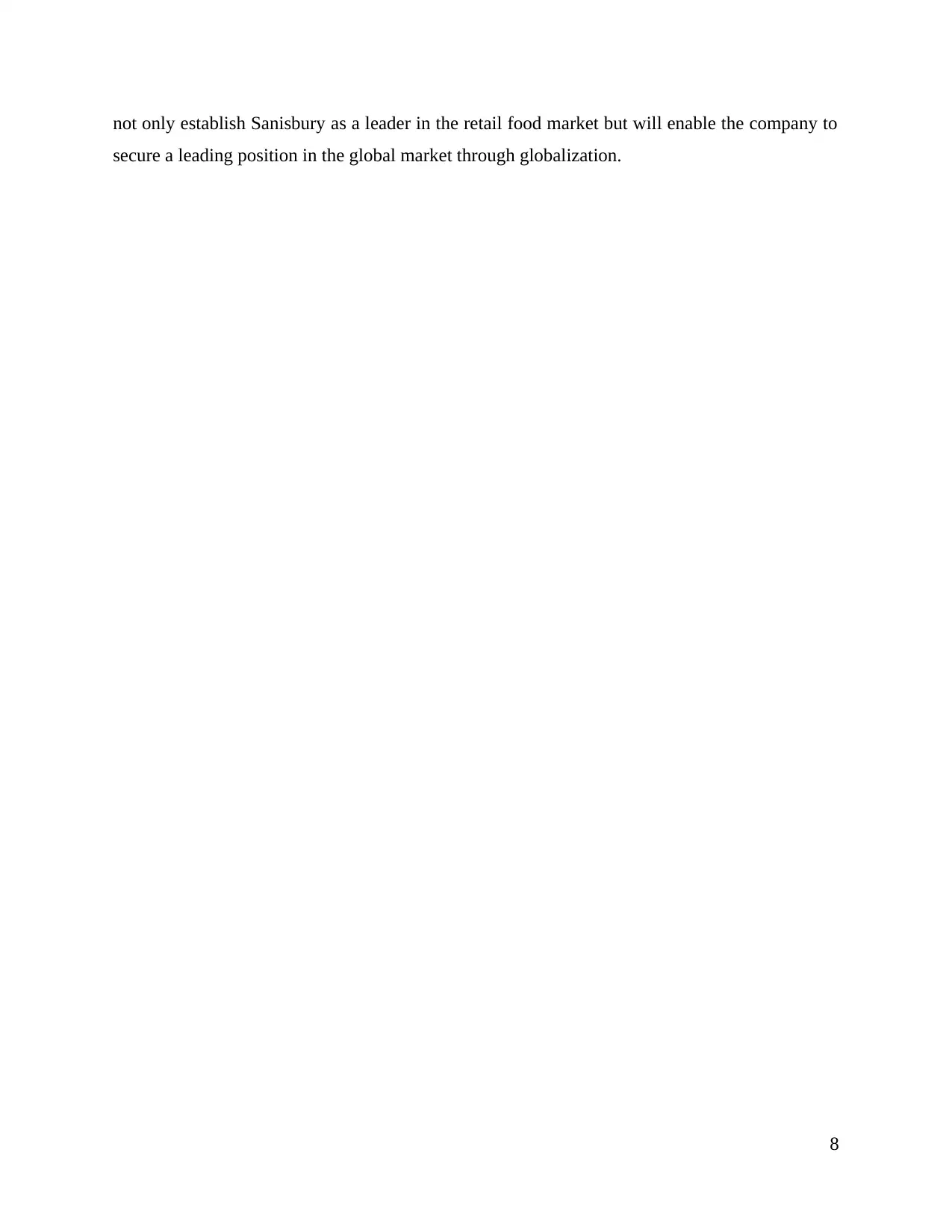
not only establish Sanisbury as a leader in the retail food market but will enable the company to
secure a leading position in the global market through globalization.
8
secure a leading position in the global market through globalization.
8
Secure Best Marks with AI Grader
Need help grading? Try our AI Grader for instant feedback on your assignments.
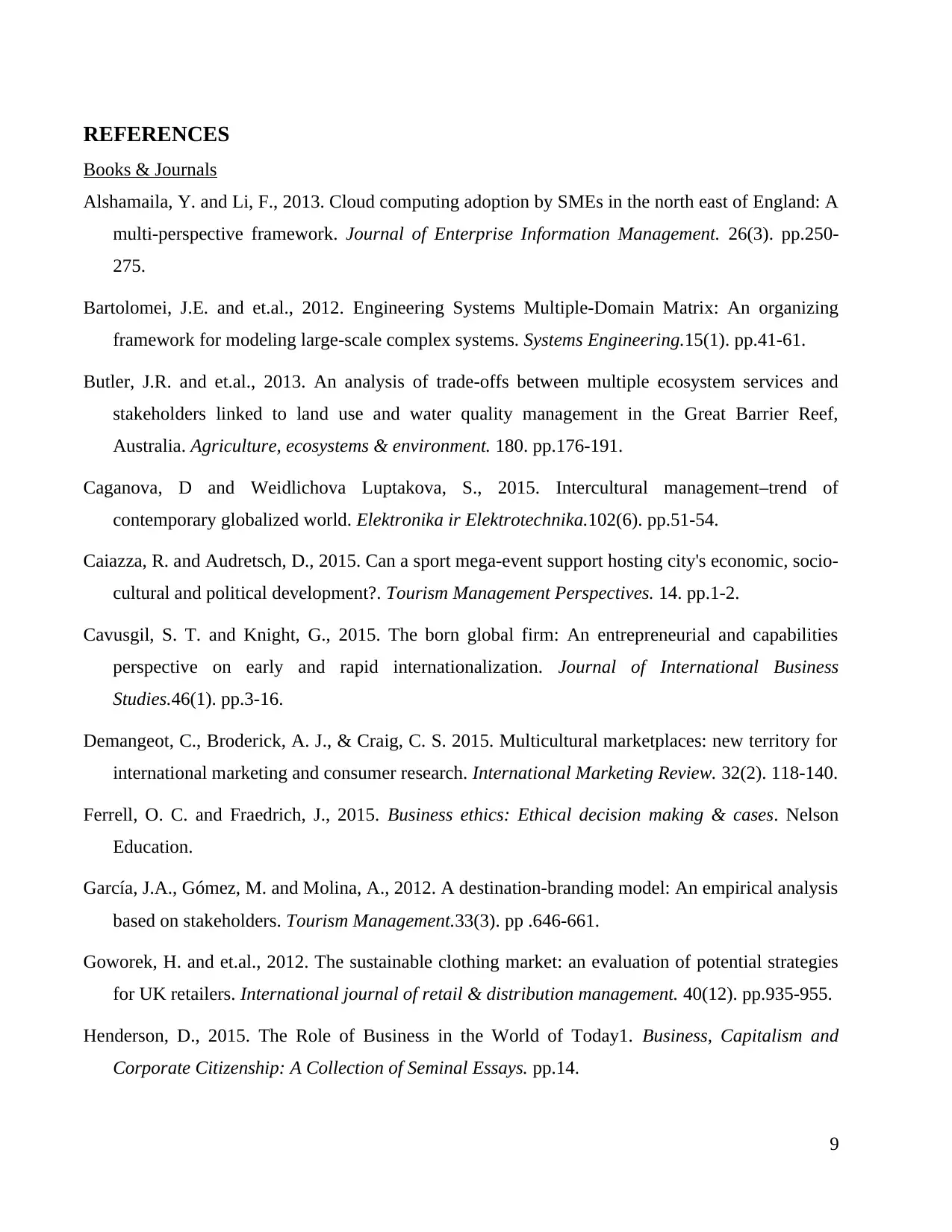
REFERENCES
Books & Journals
Alshamaila, Y. and Li, F., 2013. Cloud computing adoption by SMEs in the north east of England: A
multi-perspective framework. Journal of Enterprise Information Management. 26(3). pp.250-
275.
Bartolomei, J.E. and et.al., 2012. Engineering Systems Multiple‐Domain Matrix: An organizing
framework for modeling large‐scale complex systems. Systems Engineering.15(1). pp.41-61.
Butler, J.R. and et.al., 2013. An analysis of trade-offs between multiple ecosystem services and
stakeholders linked to land use and water quality management in the Great Barrier Reef,
Australia. Agriculture, ecosystems & environment. 180. pp.176-191.
Caganova, D and Weidlichova Luptakova, S., 2015. Intercultural management–trend of
contemporary globalized world. Elektronika ir Elektrotechnika.102(6). pp.51-54.
Caiazza, R. and Audretsch, D., 2015. Can a sport mega-event support hosting city's economic, socio-
cultural and political development?. Tourism Management Perspectives. 14. pp.1-2.
Cavusgil, S. T. and Knight, G., 2015. The born global firm: An entrepreneurial and capabilities
perspective on early and rapid internationalization. Journal of International Business
Studies.46(1). pp.3-16.
Demangeot, C., Broderick, A. J., & Craig, C. S. 2015. Multicultural marketplaces: new territory for
international marketing and consumer research. International Marketing Review. 32(2). 118-140.
Ferrell, O. C. and Fraedrich, J., 2015. Business ethics: Ethical decision making & cases. Nelson
Education.
García, J.A., Gómez, M. and Molina, A., 2012. A destination-branding model: An empirical analysis
based on stakeholders. Tourism Management.33(3). pp .646-661.
Goworek, H. and et.al., 2012. The sustainable clothing market: an evaluation of potential strategies
for UK retailers. International journal of retail & distribution management. 40(12). pp.935-955.
Henderson, D., 2015. The Role of Business in the World of Today1. Business, Capitalism and
Corporate Citizenship: A Collection of Seminal Essays. pp.14.
9
Books & Journals
Alshamaila, Y. and Li, F., 2013. Cloud computing adoption by SMEs in the north east of England: A
multi-perspective framework. Journal of Enterprise Information Management. 26(3). pp.250-
275.
Bartolomei, J.E. and et.al., 2012. Engineering Systems Multiple‐Domain Matrix: An organizing
framework for modeling large‐scale complex systems. Systems Engineering.15(1). pp.41-61.
Butler, J.R. and et.al., 2013. An analysis of trade-offs between multiple ecosystem services and
stakeholders linked to land use and water quality management in the Great Barrier Reef,
Australia. Agriculture, ecosystems & environment. 180. pp.176-191.
Caganova, D and Weidlichova Luptakova, S., 2015. Intercultural management–trend of
contemporary globalized world. Elektronika ir Elektrotechnika.102(6). pp.51-54.
Caiazza, R. and Audretsch, D., 2015. Can a sport mega-event support hosting city's economic, socio-
cultural and political development?. Tourism Management Perspectives. 14. pp.1-2.
Cavusgil, S. T. and Knight, G., 2015. The born global firm: An entrepreneurial and capabilities
perspective on early and rapid internationalization. Journal of International Business
Studies.46(1). pp.3-16.
Demangeot, C., Broderick, A. J., & Craig, C. S. 2015. Multicultural marketplaces: new territory for
international marketing and consumer research. International Marketing Review. 32(2). 118-140.
Ferrell, O. C. and Fraedrich, J., 2015. Business ethics: Ethical decision making & cases. Nelson
Education.
García, J.A., Gómez, M. and Molina, A., 2012. A destination-branding model: An empirical analysis
based on stakeholders. Tourism Management.33(3). pp .646-661.
Goworek, H. and et.al., 2012. The sustainable clothing market: an evaluation of potential strategies
for UK retailers. International journal of retail & distribution management. 40(12). pp.935-955.
Henderson, D., 2015. The Role of Business in the World of Today1. Business, Capitalism and
Corporate Citizenship: A Collection of Seminal Essays. pp.14.
9
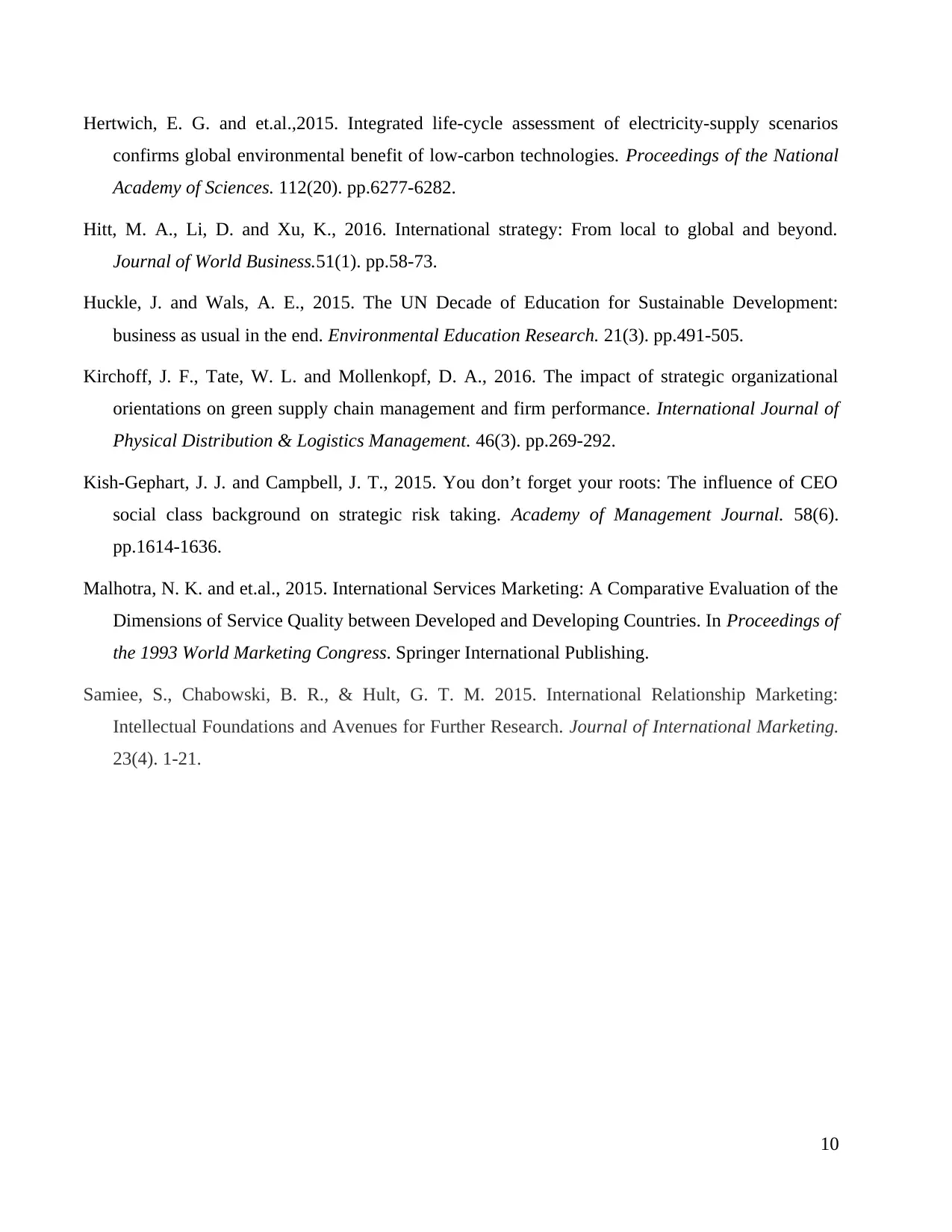
Hertwich, E. G. and et.al.,2015. Integrated life-cycle assessment of electricity-supply scenarios
confirms global environmental benefit of low-carbon technologies. Proceedings of the National
Academy of Sciences. 112(20). pp.6277-6282.
Hitt, M. A., Li, D. and Xu, K., 2016. International strategy: From local to global and beyond.
Journal of World Business.51(1). pp.58-73.
Huckle, J. and Wals, A. E., 2015. The UN Decade of Education for Sustainable Development:
business as usual in the end. Environmental Education Research. 21(3). pp.491-505.
Kirchoff, J. F., Tate, W. L. and Mollenkopf, D. A., 2016. The impact of strategic organizational
orientations on green supply chain management and firm performance. International Journal of
Physical Distribution & Logistics Management. 46(3). pp.269-292.
Kish-Gephart, J. J. and Campbell, J. T., 2015. You don’t forget your roots: The influence of CEO
social class background on strategic risk taking. Academy of Management Journal. 58(6).
pp.1614-1636.
Malhotra, N. K. and et.al., 2015. International Services Marketing: A Comparative Evaluation of the
Dimensions of Service Quality between Developed and Developing Countries. In Proceedings of
the 1993 World Marketing Congress. Springer International Publishing.
Samiee, S., Chabowski, B. R., & Hult, G. T. M. 2015. International Relationship Marketing:
Intellectual Foundations and Avenues for Further Research. Journal of International Marketing.
23(4). 1-21.
10
confirms global environmental benefit of low-carbon technologies. Proceedings of the National
Academy of Sciences. 112(20). pp.6277-6282.
Hitt, M. A., Li, D. and Xu, K., 2016. International strategy: From local to global and beyond.
Journal of World Business.51(1). pp.58-73.
Huckle, J. and Wals, A. E., 2015. The UN Decade of Education for Sustainable Development:
business as usual in the end. Environmental Education Research. 21(3). pp.491-505.
Kirchoff, J. F., Tate, W. L. and Mollenkopf, D. A., 2016. The impact of strategic organizational
orientations on green supply chain management and firm performance. International Journal of
Physical Distribution & Logistics Management. 46(3). pp.269-292.
Kish-Gephart, J. J. and Campbell, J. T., 2015. You don’t forget your roots: The influence of CEO
social class background on strategic risk taking. Academy of Management Journal. 58(6).
pp.1614-1636.
Malhotra, N. K. and et.al., 2015. International Services Marketing: A Comparative Evaluation of the
Dimensions of Service Quality between Developed and Developing Countries. In Proceedings of
the 1993 World Marketing Congress. Springer International Publishing.
Samiee, S., Chabowski, B. R., & Hult, G. T. M. 2015. International Relationship Marketing:
Intellectual Foundations and Avenues for Further Research. Journal of International Marketing.
23(4). 1-21.
10
1 out of 12
Related Documents
Your All-in-One AI-Powered Toolkit for Academic Success.
+13062052269
info@desklib.com
Available 24*7 on WhatsApp / Email
![[object Object]](/_next/static/media/star-bottom.7253800d.svg)
Unlock your academic potential
© 2024 | Zucol Services PVT LTD | All rights reserved.





